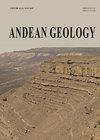How many species of the aquatic sloth Thalassocnus (Xenarthra: Megatheriidae) were in Chile?: new evidences from the Bahía Inglesa Formation, with a reappraisal of their biochronological affinities
IF 1.2
4区 地球科学
Q3 GEOLOGY
引用次数: 3
Abstract
The aquatic sloth, Thalassocnus, is one of the most intriguing lineage of mammal known from the southern pacific coast of South America during the late Neogene. It was initially recognized in Perú, but recent paleontological surveys also recorded its presence in Chile. However, the determination of how many species of Thalassocnus were actually present in Chile remains as an open question. Here, we provide a detailed morphological description of an isolated distal fragment of humerus recovered at the Mina Fosforita member (ca. 7 Ma), Bahía Inglesa Formation (Atacama Region, northern Chile), which is referred to Thalassocnus. Morphological comparisons with others forms from Chile and Perú allow us to attribute the CPUC/C/557 specimen to Thalassocnus cf. T. natans, though some degree of intraspecific variation is acknowledged. The assessment of the stratigraphic provenance of the materials with previously assigned to Thalassocnus from the Bahía Inglesa, Horcón and Coquimbo formations, permits us to propose that the taxonomic diversity of Thalassocnus in Chile is unequivocal conformed by T. carolomartini, and T. natans. We also admitted the likely presence of T. antiquus and probably T. yaucensis. Futures discoveries of more complete specimens, and/or the detailed analysis of undescribed specimens from Chile will undoubtedly contribute to illustrate the evolutionary history of the Thalassocnus radiation in Chile.智利有多少种水懒海懒(Xenarthra: Megatheriidae) ?:来自Bahía Inglesa组的新证据,并重新评估了它们的生物年代学亲和力
水生树懒Thalassocnus是新第三纪晚期南美洲南太平洋海岸已知的最有趣的哺乳动物谱系之一。它最初在秘鲁被发现,但最近的古生物学调查也记录了它在智利的存在。然而,确定智利到底有多少种海藻仍然是一个悬而未决的问题。在这里,我们提供了在Mina Fosforita成员(约7 Ma),Bahía Inglesa组(智利北部阿塔卡马地区)发现的一个分离的肱骨远端碎片的详细形态描述,该碎片被称为Thalassocnus。通过与智利和秘鲁的其他形态进行形态学比较,我们可以将CPUC/C/557标本归因于Thalassocnus cf.T.natans,尽管承认存在一定程度的种内变异。对Bahía Inglesa、Horcón和Coquimbo地层中先前归属于Thalassocnus的物质的地层来源进行评估,使我们能够提出智利Thalassocanus的分类多样性明确符合T.carolomartini和T.natans。我们也承认了可能存在的T.antiquus和T.yaucensis。未来对更完整标本的发现,和/或对智利未描述标本的详细分析,无疑将有助于阐明智利海藻辐射的进化史。
本文章由计算机程序翻译,如有差异,请以英文原文为准。
求助全文
约1分钟内获得全文
求助全文
来源期刊

Andean Geology
地学-地质学
CiteScore
3.90
自引率
0.00%
发文量
17
审稿时长
>12 weeks
期刊介绍:
This journal publishes original and review articles on geology and related sciences, in Spanish or English, in three issues a year (January, May and September). Articles or notes on major topics of broad interest in Earth Sciences dealing with the geology of South and Central America and Antarctica, and particularly of the Andes, are welcomed.
The journal is interested in publishing thematic sets of papers and accepts articles dealing with systematic Paleontology only if their main focus is the chronostratigraphical, paleoecological and/or paleogeographical importance of the taxa described therein.
 求助内容:
求助内容: 应助结果提醒方式:
应助结果提醒方式:


